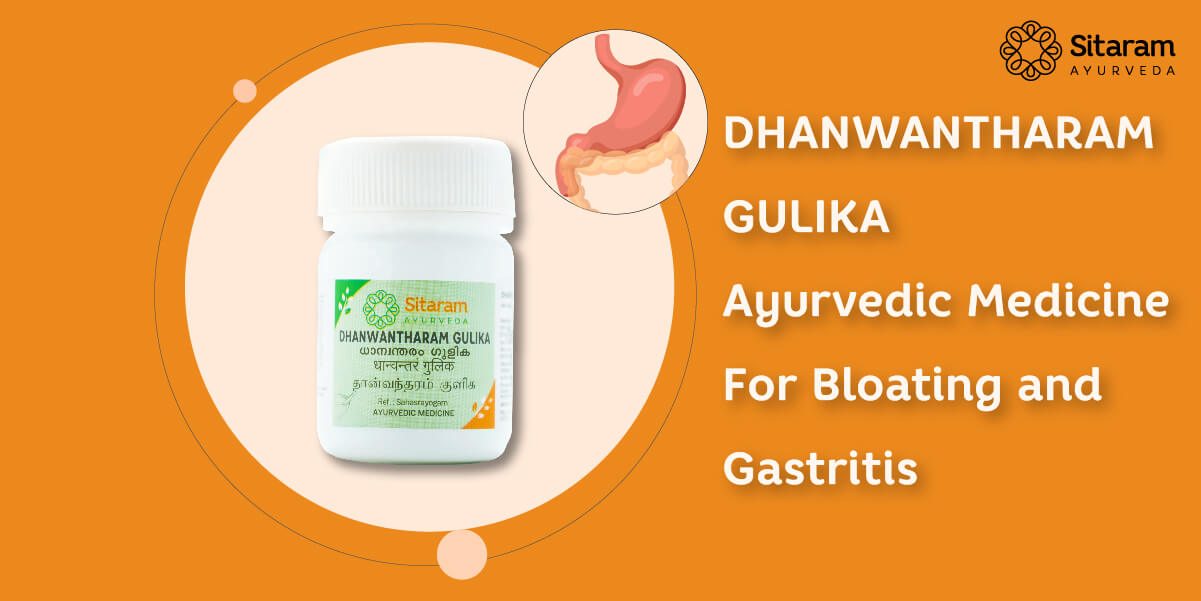Ayurvedic medicine for bloating and gastritis – Dhanwantharam Gulika

Depending on the reason, there are many treatments for gastritis. Dhanwantharam Gulika is a tablet-based Ayurvedic medication that is effective in treating gastrointestinal issues like bloating, flatulence, and gastritis. Dhanwantharam Gulika is formulated with conventional ingredients to support healthy digestion and lessen the discomfort brought on by gastric issues.
Most individuals confuse bloating with increased belly fat, which can be a transient or chronic issue. That is not the case, though. The majority of the time, digestive problems cause the stomach to swell up without any overt signs of weight gain. Don’t worry if you are having trouble buttoning your pants. To aid with bloating and other digestive troubles you might be experiencing, take Dhanwantharam pills.
Benefits of Dhanwantharam Gulika
- These pills can treat a number of conditions brought on by vitiated Kapha and Vata Doshas.
- It is a herbal remedy for acid reflux and gastritis that is entirely natural.
- It lessens pregnancy-related nausea and increases appetite.
- It aids in the treatment of respiratory conditions such bronchitis, cough, hiccups, and shortness of breath.
- Prescribed to people who experience bloating and gastritis bouts frequently
Ingredients
Ela – Cardamom small (Elettaria cardamomum), Viswa – Dry ginger (Zingiber officinale), Abhaya – Chebulic myrobalan (Terminalia chebula), Jati (Myristica fragrans), Brihati – Indian Nightshade (Solanum indicum), Arya (Andrographis paniculata), Jeeraka – Cumin (Cuminum cyminum).
Dosage
- For Adult – 1-2 Pills of Dhanwantharam gulika twice daily on empty stomach, or as advised by the physician.
- For Children – 1/2 – 1 Pill once or twice daily on empty stomach or as advised by the physician.
One of the most prevalent and dangerous pandemic infections nowadays is chronic gastritis, which can have deadly consequences like peptic ulcers or gastric cancer. Currently, perhaps more than half of the world’s population may suffer from gastritis. Because the stomach lining tends to thin with age, older adults are more likely than youngsters to have an H. pylori infection or autoimmune illnesses and are at an increased risk of developing gastritis.
The ‘mucosa’ is the protective mucus lining that lines our stomach. The stomach’s lining shields it from the powerful gastric acid that aids in food digestion. The protecting mucosa gets inflamed and leads to gastritis when something weakens or harms it. The most frequent bacterial cause of gastritis is a kind of bacterium known as Helicobacter pylori. This inflammation results in stomach pain, dyspepsia, bloating, and nausea. It can trigger other issues. Gastritis can develop gradually (chronic) or suddenly (acute). Reducing stomach acid and modifying the diet can help with gastritis symptoms.
Indigestion symptoms can resemble those of gastropathy. Indigestion is a stomach ache or discomfort brought on by trouble digesting food. It could feel like a burning sensation between your lower ribs. Indigestion is medically referred as dyspepsia. About 8 out of every 1,000 people get acute (sudden) gastritis. Long-term, chronic gastritis is less frequent. Approximately two out of every 10,000 people are impacted.
Types of Gastritis
- Erosive Gastritis (Reactive) – Erosive gastritis results in both stomach lining erosion and inflammation. Reactive gastritis is another name for this condition. Alcohol, smoking, NSAIDs, corticosteroids, viral or bacterial infections, stress from diseases or injuries are some of the major causes.
- Non-erosive – Stomach lining inflammation that does not cause erosion or compromise the lining.
Causes of gastritis
Gastritis develops when the stomach lining is harmed or weakened. This issue may be caused by a variety of factors, including:
- Abuse of alcohol: Prolonged drinking can irritate and damage the stomach lining.
- Autoimmune disease – In certain people, the stomach lining’s healthy cells are attacked by the immune system.
- Bacterial infection – Peptic ulcer illness and chronic gastritis are mostly brought on by the H. pylori bacterium (stomach ulcers). Inflammation is brought on by the bacteria’s destruction of the stomach’s barrier lining.
- Reflux of bile – Your liver produces bile to aid in the digestion of fatty foods. Reflux is a reflowing action. When bile bypasses the small intestine and instead rushes back into the stomach, this condition is known as bile reflux.
- Medication – Regularly taking corticosteroids or nonsteroidal anti-inflammatory medications (NSAIDs) to treat chronic pain can irritate the stomach lining.
- Stress on the body – A sudden, serious sickness or injury might cause gastritis. Gastritis frequently occurs even following trauma to the body that does not affect the stomach. Brain injuries and severe burns are two common causes.
What symptoms are present in gastritis?
There are many cases of gastritis without symptoms. When symptoms do occur, many people mistake them for indigestion. Additional indications of gastritis include –
- Tarry and Dark stools
- Bloating
- Vomiting and Nausea
- Decrease in appetite.
- Abdominal ulcers
- Weight loss
- Discomfort or soreness in the upper abdomen
- Vomiting blood.


 Sign In
Sign In Cart
Cart
I am suffering from moderate to acute gastritis for past 3 years and looking for guidance on what ayurvedic medicine will suit my prakruti. Could you please advise?
Hi
For an online consultation, please visit :
https://bit.ly/3vy1F4d
Our doctors would be happy to assist you better.